AMD Radeon R7 SSD (240GB) Review
by Kristian Vättö on August 28, 2014 6:00 AM ESTRandom Read/Write Speed
The four corners of SSD performance are as follows: random read, random write, sequential read and sequential write speed. Random accesses are generally small in size, while sequential accesses tend to be larger and thus we have the four Iometer tests we use in all of our reviews.
Our first test writes 4KB in a completely random pattern over an 8GB space of the drive to simulate the sort of random access that you'd see on an OS drive (even this is more stressful than a normal desktop user would see). We perform three concurrent IOs and run the test for 3 minutes. The results reported are in average MB/s over the entire time.
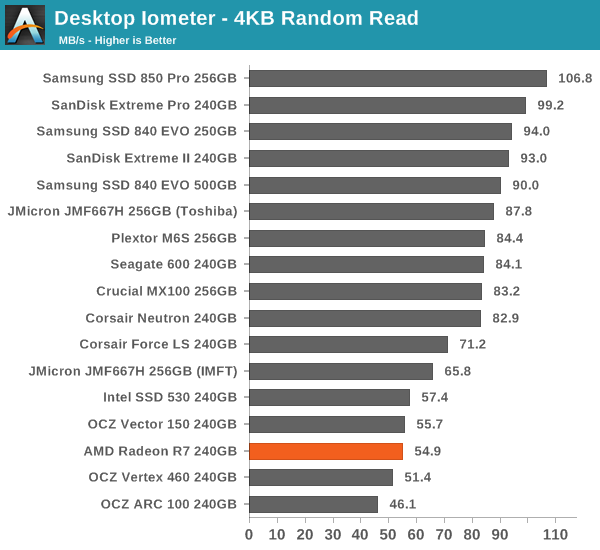
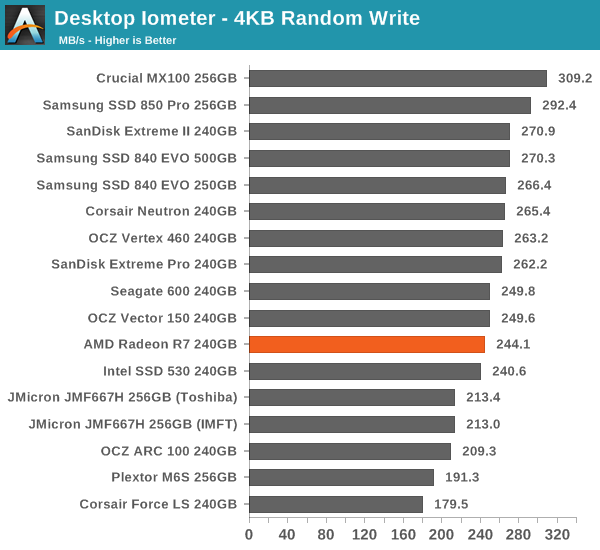
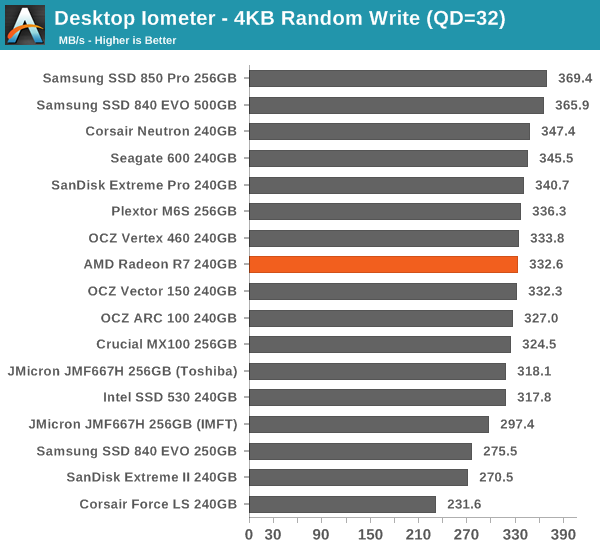
Random performance remains similar to other Barefoot 3 SSDs. Peak performance has never been Barefoot 3's strength, which is why especially random read performance seems slow for a modern drive, but the lack of peak performance is compensated by sustained consistency.
Sequential Read/Write Speed
To measure sequential performance we run a 1 minute long 128KB sequential test over the entire span of the drive at a queue depth of 1. The results reported are in average MB/s over the entire test length.
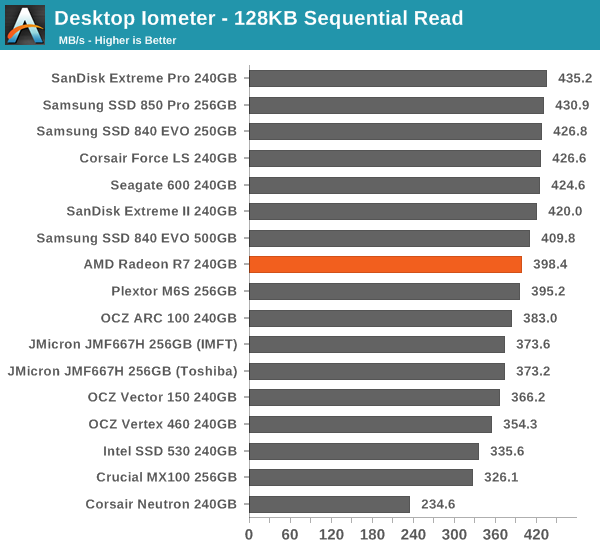
Sequential read performance receives a nice upgrade from the Vector 150 and Vertex 460, although that comes at the cost of sequential write speed. It is quite common that an increasing in one benchmark leads to a decrese in another as in the end firmware design is about finding the right balance for IO priorization.

AS-SSD Incompressible Sequential Read/Write Performance
The AS-SSD sequential benchmark uses incompressible data for all of its transfers. The result is a pretty big reduction in sequential write speed on SandForce based controllers, but most other controllers are unaffected.

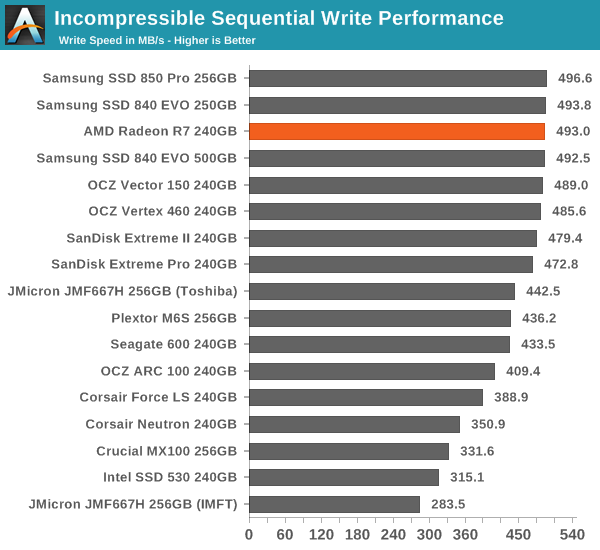










54 Comments
View All Comments
yannigr2 - Thursday, August 28, 2014 - link
Fear only Intel and Nvidia buttons in the front page. An AMD button is just an AMD button. AMD's pockets are empty to influence Anandtech like the other two firms are already for years and without front page buttons influencing other major sites.yannigr2 - Thursday, August 28, 2014 - link
I can only explain like this the high price compared with other disks that perform the same- It targets AMD fans who are willing to pay a little extra for the sticker with the "Radeon" brand on it.
- Rebranding and selling someone else's disk does add extra costs.
- It's not meant really for retail. This is a disk that will improve the total package that an OEM will take from AMD.
SleepyFE - Thursday, August 28, 2014 - link
I think the drive is a bit much for OEMs. That said, it would be good if PCs under 600$ came with an SSD.ExarKun333 - Thursday, August 28, 2014 - link
Seriously AMD? The pricing is terrible and you are essentially looking to sell an inferior product for more than a superior one. Why? smhDoach - Thursday, August 28, 2014 - link
Love the SSD reviews Kristian. Very well written and informative.Curious, why haven't you tested a toshiba q pro series SSD yet? You have tested their partners SSDs but not theirs. According to other sites the performance is about the same as a samsung 840 pro, which is a top performer. The price is right also.
Would love to see you review this model. I saw the reviews on the other sites but your reviews are better in my opinion.
www.amazon.com/Toshiba-512GB-Series-Internal-HDTS351XZSTA/dp/B00FR6VM54/ref=sr_1_3?ie=UTF8&qid=1409228046&sr=8-3&keywords=Toshiba+ssd
www.tweaktown.com/reviews/6057/toshiba-q-series-pro-256gb-ssd-review-offers-great-value/index.html
Kristian Vättö - Thursday, August 28, 2014 - link
I met with Toshiba for the first time at FMS a few weeks ago and we didn't have a direct contact before that. Let me get in touch with them to see if they can send us some samples.Doach - Thursday, August 28, 2014 - link
That would be great! Looking foward to another great review.Thanks for the reply kristian.
LiviuTM - Thursday, August 28, 2014 - link
Great review, as always.Indeed, MSRP is not competitive at all.
A simple conversion shows the 512GB drive would cost ~220 Euros and that's without taking into account the taxes you pay in Europe.
There are obviously much better choices. Here in Romania you can buy the 512 GB Crucial MX100 for 207 Euros. An even better deal is the 512 GB Crucial M550 which right now is running for just 5 Euro more than MX100 (212 Euros!), after a recent 50 Euro price slash.
i don't need another SSD, otherwise I would have jumped on the offer with my eyes closed.
kyuu - Tuesday, September 2, 2014 - link
Except you can't simply convert the US price to Euros and take that as the price it would be sold for in Europe. That isn't how pricing works.You're also comparing MSRPs to "street" prices. SSDs in particular often sell for much less than their MSRP.
The_Assimilator - Thursday, August 28, 2014 - link
Now all we need are Radeon-branded motherboards and power supplies, and you could build a full system that's shit from top to bottom.